| |
|
Written by New York based poster collector Bill Edmonds.
|
Poster collecting can be one of the most rewarding pastimes there is and has turned for many hobby collectors into a business. One of the fastest growing areas in poster collecting has been in movie and fine art posters signed by actors and artists. Collecting posters to decorate home walls has always been a passion for many people and with much higher prices paid today for some posters it has moved from poster collecting into poster investing. Poster collecting is an affordable investment that anyone can do. It is recommended that you buy posters you like rather than the ones you think should be valuable in the future. Each month I buy one or two posters that I hang in my media room. Once I have bought a new poster I take the old one down and save it in a large acid free folder for the future. If you are intending to start a collection just remember to go for what inspires you, and for what is different. One of my favourite posters to collect has been those signed by singers, actors and artists, these are however more difficult to acquire as famous people tend to be reclusive. When buying posters signed by famous people always try to attain some form of proof that the person actually signed it. Usually a photograph of the person signing the poster or a certificate of authenticity will do. Whenever I ask someone sign a poster for me I always try to take a photograph of that person signing, this validates the signatures authenticity. If you would like to start a poster collection only buy originals and never buy copies of originals. Some posters are later reprinted in a so called second run or edition, try at all times to get the first edition. Below are some of my favourite posters I have collected to date.
|
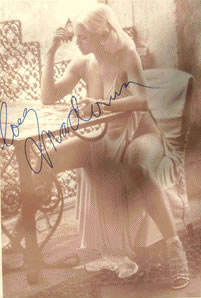 |
|
Madonna's signature was acquired outside of her residence in the west 60's in Manhattan. I have two Madonna signed posters in my collection. This poster was issued in 1995 by OSP Publishing. The photograph is entitled "Spain" and was photographed by Steven Meisel. The poster measures 23" x 35". The day that Madonna signed this poster it was a somewhat windy day unfortunately and the poster condition is Grade C
|
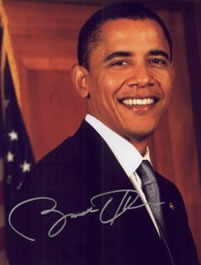 |
|
I was lucky enough to have Senator Barack Obama sign this poster three weeks before his decision to run for the Presidency. The rest is history!
Collecting posters signed by famous people like actors, musicians, artists and politicians can be very rewarding.
Grade B
|
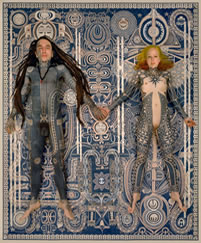 |
|
Posters are iconic tools not only for self expression, but are a vessel of information. Challenging the world in which we live. Some posters transcend beyond the limits of its creation, thus becoming an international language without borders. This fine art poster (left) is one of my favourites and is by the artist Garry Orriss. It is number 7 of 150 and is a limited edition poster. It is the only poster I have ever seen since I started collecting posters twenty years ago that is printed on the back in several languages, it came with a certificate of authenticity is by far the most challenging poster I have in my collection. Issued in 2007 by GoArt.com the poster measures 1000 x 700 mm.
|
Over the last ten years I have started to expand my collection into new areas focusing more on contemporary issues like urban and social change, cultural posters and propaganda, especially the older ones from Germany, China and Russia. Every poster collector will at sometime buy a poster of a movie that he or she liked. An exciting area for me is the Indie or cult film poster scene, these posters were printed in far less numbers than the Hollywood studio posters and were not so widely distributed. This has made them very popular with collectors. Independent film makers often had small budgets for films and this meant that they would spend more time in creating a better looking and designed poster to get the people in to see their films.
|
COLLECTING HISTORICAL POSTERS |
Many factors attribute to a vintage posters price and these include:
Originality of Design: As with any collectable people are always on the lookout for posters that are eye catching and have a strong visual presence or design to them. Such posters sell for higher prices at auctions, this is especially true if the posters are thought provoking, challenging and somewhat before their time. The design and desirability of any poster is the second most important factor when deciding its price so choose posters that are desirable and based on strong design principals.
The Artist: Posters that are made by recognized artists will always have a higher value. Artists like Toulouse-Lautrec and Jules Cheret created an air of respectability with this new art media and made it very glamorous and fashionable. Since their time many established artists have worked within this field and today collectors are exposed to so many new and specialized areas of collecting.
The Subject: A particular theme or subject of a poster will often affect its demand, automobiles and trains will no doubt be more popular than soap. The most desirable posters to collect have been of artworks and of the universally loved films, such as the Wizard of Oz, Casablanca and so on.
Rarity: Vintage posters from the early 1890s through to the 1950's usually command the highest prices. Posters that were produced for advertising on billboards in small runs of 250 to 3000 often did not survive. The rarer a poster is the more it will sell for, though rarity can be sometimes difficult to determine by poster purveyors. Most early printing workshops did not keep records of how often a particular type of poster was made. The only ones that survive today are those that were originally saved by artists, clients, collectors, museums, or were found in the printer's warehouse. As many new collectors enter the market today and with museums and collectors offering more money than ever before, the availability and price for a particular poster can skyrocket.
|
Poster Conservation Techniques: There are a number of steps you can take to protect and enhance the monetary value of your poster. Golden Age Posters were made with the cheapest and lowest quality acidic paper, they were never meant to be valuable collectibles and were designed to have a very short life time. It is due to the acidity in the paper that vintage posters can literally devour themselves over time. Even if stored under perfect conditions in a cool dry place the process known as "acid burn" will continue to devastate the poster over a number of years. To stop this acid burn it is essential that the poster be de-acidified. The De-acidification process involves using an alkaline based substance to naturalise the PH value of the paper. Any re-touching that is made to a vintage poster should be reversible and done with watercolour pencil or gouache paint. The poster is then removed from its linen backing ready for acid washing. If your poster is extremely rare we recommend using a process known as inert mylar encapsulation. This technique is used on the worlds oldest and most valuable manuscripts. It involves cutting two polyester (mylar) sheets and sandwiching the poster between them, the edges are then joined and sealed leaving only the corner tips open for circulation. The main advantage here is that the poster just floats within the film and can be removed at any time by cutting open the mylar. When framing posters use only acid-free matting and backing boards as well as UV-resistant Perspex, Perspex is better than glass because glass can break. See your professional framer or technician for details.
|
Although printed public advertisements can be traced back to the early 15th century, these were made as woodblock prints with very few colours and no sense of design. The poster as we know today did not emerge until the 1860's in Paris. Their creation came from the lithographic process which ironically was invented 60 years earlier in 1798 by the German Alois Senefelder. The word poster is believed to be from the French word to "post" (fasten to a post) and emerged as a cheap, easy and eye catching way to convey information. The first posters advertised theatre productions and museum events in Paris in 1869. Their rich flowing designs and vibrant colour schemes meant they had instant appeal among the general public, it wasn't long before people began stealing and removing posters from shops fronts and billboards to use as home decoration. Printers soon ran extra copies to sell to the public and by 1896 it was quite common for people to hold Poster parties, similar to today's Tupperware or lingerie parties. People would come dressed as their favourite poster character and could win prizes for having the best resemblance. Experts estimate that by 1896 there were as many as 6000 serious collectors throughout Europe and North America. Posters were advertising everything from products, tourist destinations, films, art exhibitions even circuses. Over time their themes began to reflect more contemporary and pressing issues like urban living and politics. With the outbreak of World War I in 1914, the poster became an important tool that could influence history. Governments soon began realizing the posters power in propaganda. Probably the most famous poster from this period was the United States Uncle Sam pointing his finger and saying "I Want You". National tendencies formed with the Germans leaning more towards abstraction and the English to romanticism. Since the First World War some artists have deliberately challenged the traditional languages of poster art, but the majority have just gone with the flow hoping to be somehow seen to be different, these ended up in just chasing the fads. Posters that challenge the genres of public opinion or are somewhat before their time are always bought by collectors.
|
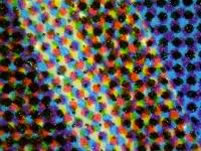
A 200x magnification of a modern offset press Garry Orriss poster.
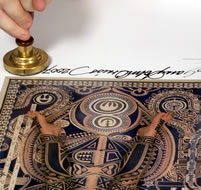 The same poster above being singed by the artist.
The same poster above being singed by the artist.
|
|
Poster Printing:
The method for printing posters from the mid 1880s to late 1930s was with the time consuming and highly valued process known as stone lithography. Each colour was individually drawn or painted onto a slab of porous limestone which was fixed with acid. Paper was then positioned over the stone and pressed with the ink being absorbed by the paper. After each stage was complete the paper was dried and the limestone slab was washed and prepared with a new colour. In extreme cases this could involve up to 17 individual colour applications. This meant that up to 17 limestone slabs could be used just for one poster, an extremely laborious task. The vibrancy of colour and the texture achieved in stone lithography is unsurpassed even today, however the paper and ink quality was extremely poor. This means that many vintage posters require professional conservation. After World War II stone lithography was replaced completely by the newer photo offset and silkscreen process that was introduced by Gischia in 1935. Modern posters reveal small dots when magnified similar to the ones shown on the Garry Orriss poster (top right). Vintage posters have small cross markings known as printer's registration marks these were used in order to keep the colour applications in their appropriate places when a new colour stone was being introduced.
|
Today lithographic and offset press poster art especially from Germany, Switzerland, Japan and Poland can be quite spectacular. The worlds largest poster collections are housed in the Louvre Paris, the Metropolitan Museum of Art and the Museum of Modern Art in New York, the Library of Congress in Washington, D.C. and the German Plakat Museum which houses well over 450,000 posters. The first artist to hold an exhibition of their poster art was Jules Cheret in 1880. He is credited as the father figure of poster art, and made this profession glamorous and highly respectable. Jules Cheret was awarded the Legion of Honour in 1899 for his contribution to society. Other artists include Toulouse Lautrec, Marc Chagall, Aubrey Beardsley, Alphonse Mucha and Pierre Bonnard. Since then many other top artists include Will Bradley, J.J. Gould, Will Carqueville and Edward Penfield. Norman Rockwell also made some posters and Saul Bass is famous for his Hitchcock and Otto Preminger posters. Contemporary artists such as Shepard Fairey who did the Obama poster and Garry Orriss with his tattoo art and cannibal posters are also notable.
|
Extremely rare posters will always fetch highest prices as they are rescued fragments from a lost past. In 1963 workmen who were extending a room at the Parisian literary journal found 372 Toulouse Lautrec posters rolled up under the floorboards. Many of these posters were dramatic depictions of Parisian personalities characterized by rich flowing and organic lines and colours with a motion that captured the ecstasy of the moment. Some of the posters were sold for $100 each. Ten years later one New York art dealer had almost 100 copies of Lautrec's Divan Japonais and was selling these for $800 each. Today these posters are selling for around $55,000 each. In 1989 a 3-sheet Moulin Rouge poster created by Toulouse Lautrec sold for $220,000, this was at the time the highest price paid for a poster at auction. If the Moulin Rouge poster were auctioned today it would probably double that price. Rare artist posters and vintage posters have surged in price over the last decades. Collecting vintage posters really only started in the 1970s and popular artists to collect were famous names like Toulouse Lautrec, Jules Cheret and Alphonse Mucha. Soon poster collecting broadened to include many art styles like Art Deco and of the well known artists working within these styles like Cassandre and Fix-Masseau. Since the 1970s the market for collecting vintage posters has matured and broadened greatly. Below I have listed some of the worlds most expensive posters.
|
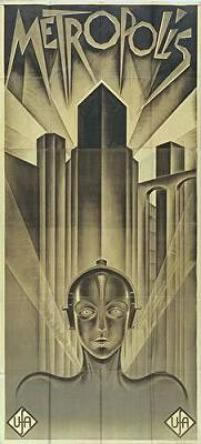 |
|
The Worlds most expensive poster 'Metropolis' was sold for 600,000 Euros on November 15, 2004, and is today the highest price ever paid for a vintage poster. It was sold by the Reel Gallery London at auction and was purchased by Ken Schacter, a famous American poster collector from California. The Metropolis poster was designed by artist Heinz Schlutz-Neudamm in 1927 in an Art Deco style. There are only four posters of Metropolis that are known to exist. One is housed in the German Film Museum Berlin, the Museum of Modern Art New York and the third is in a private collection. The film Metropolis was a Fritz Lang science fiction film based on the social crisis between the slave workers and the owners in capitalism. The film portrays the dystopia of Berlin in the futuristic year of 2026 and was the longest and most expensive silent film ever made. The films release date was January 10, 1927 and was a major flop. The production costs for Metropolis was over 17 million Euros in today's money and it bankrupted the UFA film company. Prior to this Metropolis poster being sold the previous record was for the 1932 classic movie poster "The Mummy" seen below.
|
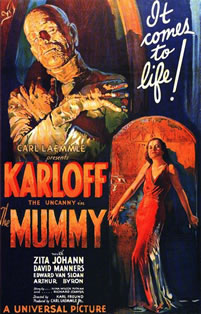 |
|
This 1932 movie poster from the film "The Mummy" sold at a Sotheby's auction in 1997 for $ 453,500.00. This one-sheet poster of The Mummy measures 27 x 41 inches and is one of the most highly valued movie posters of all time. The film was made in 1932 for an estimated $196,000 and released on December 22, 1932. The design of this poster is typical of the artist Karoly Grosz who designed many of Universal's horror movie posters at the time. These include Frankenstein 1931 and the Dracula 1931 movie poster seen below.
|
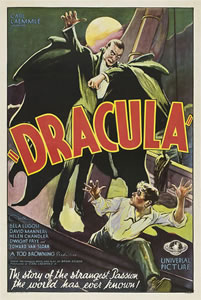 |
|
One of the all-time classics. This Dracula poster of 1931 was sold by Heritage Auctions on March 22, 2009 for $310,700 to the American super collector Ralph DeLuca. It is a single sheet measuring 27×41 inches and is one of only three copies known to exist. The cinema film was produced by Universal Pictures at a cost of $355,000 and proved to be a major box office success. Within 48 hours of Dracula opening at New York's Roxy Theatre, it had sold 50,000 tickets. This poster was found in a store room at the Roxy and held in safe keeping. In 1970 it was sold for only ten dollars. This poster was also once in the private collection of actor Nicolas Cage.
This article was prepared and written by Bill Edmonds for GoArt.com. Bill Edmonds is a New York based poster collector of rare and interesting posters.
|
BUY A INTERESTING POSTER FOR YOUR COLLECTION |
|
Signed or Unsigned by the artist, Hurry! Signed Posters are becoming rare!
|
Voted International Poster of the Year this extraordinary Garry Orriss photo poster will make an outstanding addition to your collection. This is a
1st Edition
! There are only
150
signed posters by the artist and 2950 unsigned posters. A list of museums that have already bought this poster to add to their International Poster Collections can be found below! Buy this poster direct from the artist's studio by clicking on the
blue BUY NOW
below and save!
|
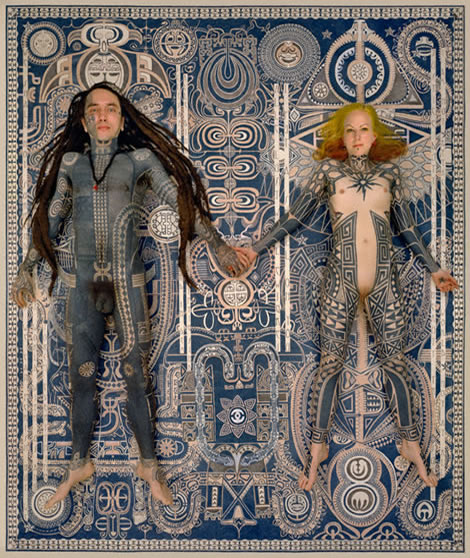
|
|
Special Tattoo Art Poster
Artist: Garry Orriss 1967
Condition: Mint A+
Title: Mario and Yvonne, Plate 8.
Size: 100cm x 70cm / 39¼ " x 27½"
Poster Type: Offset Press.
Printed: January 2007.
Print Run: 2950 Posters, Unsigned.
Signed Posters: Only 150 signed.
Notes: We sell only signed & unsigned posters, No reprints or copies. Signed posters come with a certificate of authenticity. On the back of each poster is information in English, German, Spanish and French.
Only
6
printers proofs exist & will be soon released for sale Contact us for pricing.
|
Hurry! This Garry Orriss extreme photo-art tattoo poster has now been collected by the following Museums for their International Poster Art Collections. Reserve your photo art poster now!
|
The Library of Congress Washington DC, U.S.A. - The Danish Poster Museum, Arhus, Denmark - The Poster Gallery, Zurich, Switzerland - The Folkwang Museum, Essen - The Grupo Catalográfica Poster Collection, La Paz, Bolivia - The Poster Museum at Wilanów, (part of the National Museum of Warsaw), Warsaw, Poland - The Colorado State University, International Poster Collection, Fort Collins, U.S.A. - The OnAngels Poster Art Collection, U.S.A. -
|
|
|